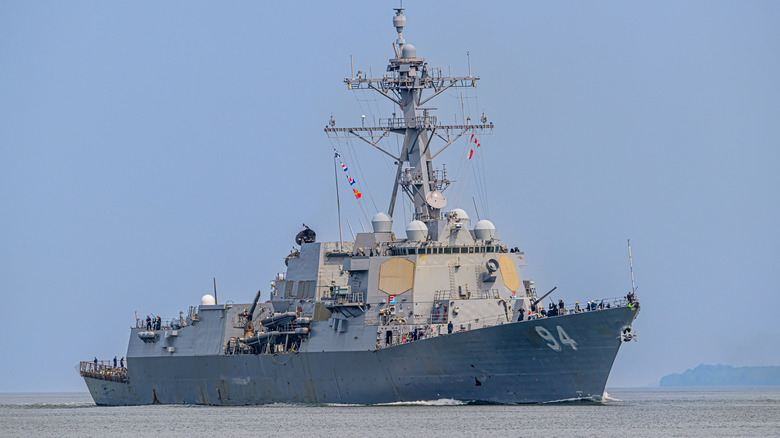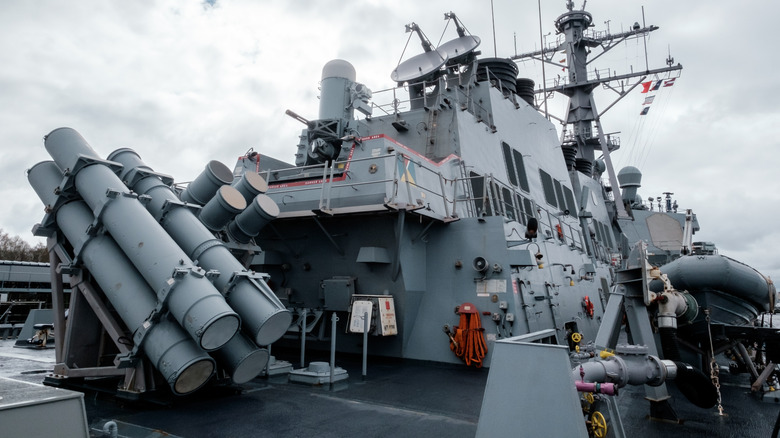How Far Can A US Navy Destroyer Ship Shoot?
The capability, versatility, and vital role of a navy destroyer in contemporary naval warfare make it an important ship within a country's naval force. Tasked with protecting larger vessels and projecting power, destroyers are built to be swift and agile and can operate independently or as part of a larger fleet, serving as escorts. Destroyers are equipped with a wide range of weapons, which allows them to support other ships in a fleet and counter different threats. Most destroyers are armed with short, medium, and long-range weaponry, and their longest-range weapons are naval cruise missiles, which can have a range between 65 and 650 miles.
The photo above shows the American Navy Arleigh Burke class, which is a great example of a naval destroyer. It has several weapon systems that allow it to engage targets at various distances, starting with its Phalanx close-in weapon systems, or CIWS, for very short-range defense, and has a 1,625 to 6,000-yard range. Next is its Rolling Airframe Missile system, another short-range weapon with a range of 6.2 miles, and lastly are its 5-inch, 54-calibre guns, with a 20 nautical mile range.
For its medium-range weapon, Arleigh Burke-class destroyers have the Evolved SeaSparrow Missile with a range of 27 nautical miles, and the RUM-139 VL-ASROC anti-submarine 11 missile, which has a ten-mile range. For targets that are further away, the destroyer has the Harpoon, another anti-ship missile that can go 67 miles, and the anti-ship counter projectile called the Standard Missile 2, capable of a 90 nautical mile range. To engage and assault adversaries beyond visual range, the Arleigh Burke-class destroyer can utilize its longest ranged weapon, the Tomahawk Cruise Missile, which can hit targets as far as 1,500 miles away.
Deadly and powerful warship
The Arleigh Burke class is one of the most powerful naval destroyers in the world and is outfitted with diverse weapons platforms. This is because each system is specific to different mission roles: anti-air warfare, anti-surface warfare, and anti-submarine warfare. For anti-air missions, the destroyer will use sensors to identify and track airborne threats and engage with its CIWS or its SM missile systems. When conducting anti-surface missions, the destroyer will track and neutralize surface ships using its guns, Harpoon, SeaSparrow or Tomahawk missiles. Finally, for anti-submarine warfare, the Arleigh Burke-class will deploy its ASROC Anti-submarine missile.
To ensure the accuracy and effectiveness of its weapons, naval destroyers depend on radar, sonar, and guidance systems to provide vital navigation, targeting, and situational awareness. For the Arleigh Burke-class destroyers, its Aegis Combat System is formidable and deadly by integrating powerful computers and cutting-edge radar technology with its extensive arsenal of weapons. Capable of detecting and tracking threats automatically, the Aegis Combat System can swiftly and accurately subdue or eliminate a variety of threats, including missiles and planes.
Because of its value in naval defense and warfare, destroyers are often upgraded to incorporate the latest weapons and defensive technologies. Two recent developments for destroyers include the launch of the new Zumwalt-class destroyer of the U.S. Navy, which is currently its biggest destroyer, and the launch of the DDG X program, which emphasizes improved capabilities, survivability, and upgradability. Additionally, the U.S. Navy has recently implemented virtual and augmented reality technology for its ship maintenance systems to boost repair efficiency during combat scenarios. By improving its capabilities, the destroyer meets and exceeds in its role, ensuring continued relevance in naval operations.

